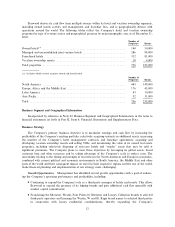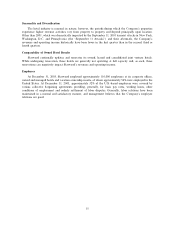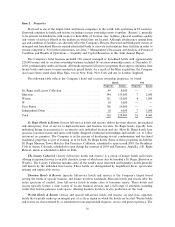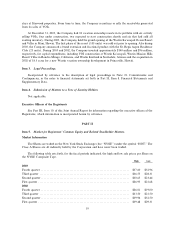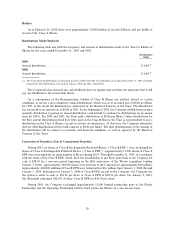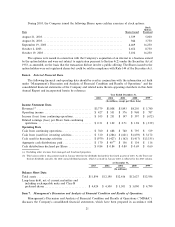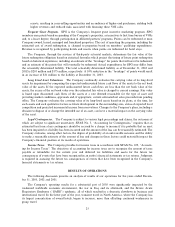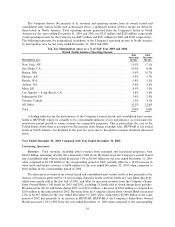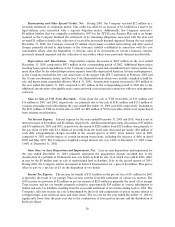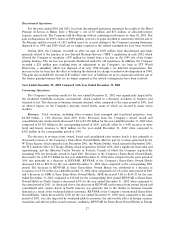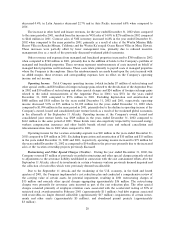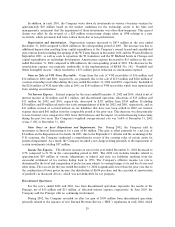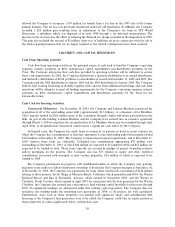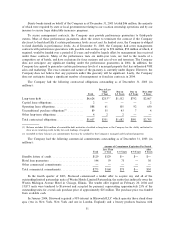Starwood 2003 Annual Report Download - page 32
Download and view the complete annual report
Please find page 32 of the 2003 Starwood annual report below. You can navigate through the pages in the report by either clicking on the pages listed below, or by using the keyword search tool below to find specific information within the annual report.accounting principles generally accepted in the United States. The preparation of these consolidated Ñnancial
statements requires management to make estimates and assumptions that aÅect the reported amounts of
assets and liabilities, the disclosure of contingent assets and liabilities at the date of the consolidated Ñnancial
statements and the reported amounts of revenues and costs and expenses during the reporting periods. On an
ongoing basis, management evaluates its estimates and judgments, including those relating to revenue
recognition, bad debts, inventories, investments, plant, property and equipment, goodwill and intangible assets,
income taxes, Ñnancing operations, frequent guest program liability, self-insurance claims payable, restructur-
ing costs, retirement beneÑts and contingencies and litigation.
Management bases its estimates and judgments on historical experience and on various other factors that
are believed to be reasonable under the circumstances, the results of which form the basis for making
judgments about the carrying value of assets and liabilities that are not readily available from other sources.
Actual results may diÅer from these estimates under diÅerent assumptions and conditions.
CRITICAL ACCOUNTING POLICIES
The Company believes the following to be its critical accounting policies:
Revenue Recognition. The Company's revenues are primarily derived from the following sources:
(1) hotel and resort revenues at the Company's owned, leased and consolidated joint venture properties;
(2) management and franchise fees; (3) vacation ownership revenues; and (4) other revenues which are
ancillary to the Company's operations. Generally, revenues are recognized when the services have been
rendered. The following is a description of the composition of revenues for the Company:
‚ Owned, Leased and Consolidated Joint Ventures Ì Represents revenue primarily derived from hotel
operations, including the rental of rooms and food and beverage sales from owned leased or
consolidated joint venture hotels and resorts. Revenue is recognized when rooms are occupied and
services have been rendered. These revenues are impacted by global economic conditions aÅecting the
travel and hospitality industry as well as relative market share of the local competitive set of hotels.
REVPAR is a leading indicator of revenue trends at owned, leased and consolidated joint venture
hotels.
‚ Management and Franchise Fees Ì Represents fees earned on hotels managed worldwide, usually
under long-term contracts, and franchise fees received in connection with the franchise of the
Company's Sheraton, Westin, Four Points by Sheraton and Luxury Collection brand names. Manage-
ment fees are comprised of a base fee, which is generally based on a percentage of gross revenues, and
an incentive fee, which is generally based on the property's proÑtability. For any time during the year,
incentive fees are recognized for the fees due and earned as if the contract was terminated at that date,
exclusive of any termination fees due or payable. Therefore, during periods prior to year-end, the
incentive fees recorded may not be indicative of the eventual incentive fees that will be recognized at
year-end as conditions and incentive hurdle calculations may not be Ñnal. Franchise fees are generally
based on a percentage of hotel room revenues. As with hotel revenues discussed above, these revenue
sources are aÅected by conditions impacting the travel and hospitality industry as well as competition
from other hotel management and franchise companies.
‚ Vacation Ownership Ì The Company recognizes revenue from VOI sales and Ñnancings. Such
revenues are impacted by the state of the global economies and, in particular, the U.S. economy, as
well as interest rate and other economic conditions aÅecting the lending market. The Company
determines the portion of revenues to recognize for sales accounted for under the percentage of
completion method based on judgments and estimates including total project costs to complete.
Additionally, the Company records reserves against these revenues based on expected default levels.
Changes in costs could lead to adjustments to the percentage of completion status of a project, which
may result in diÅerences in the timing and amount of revenues recognized from the projects. The
Company anticipates developing future high end VOI projects adjacent to or as part of its luxury
22


